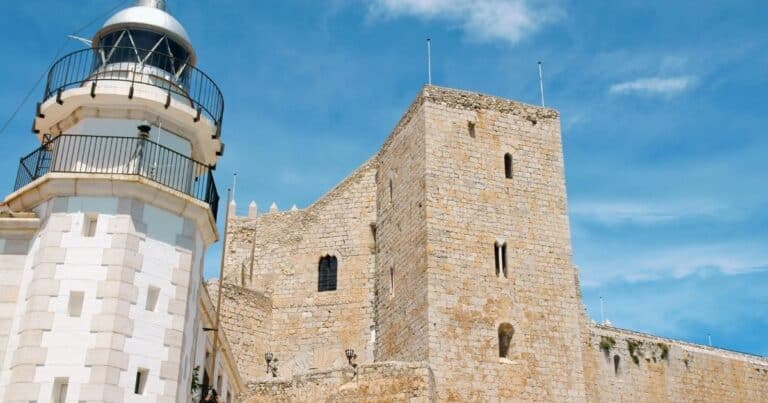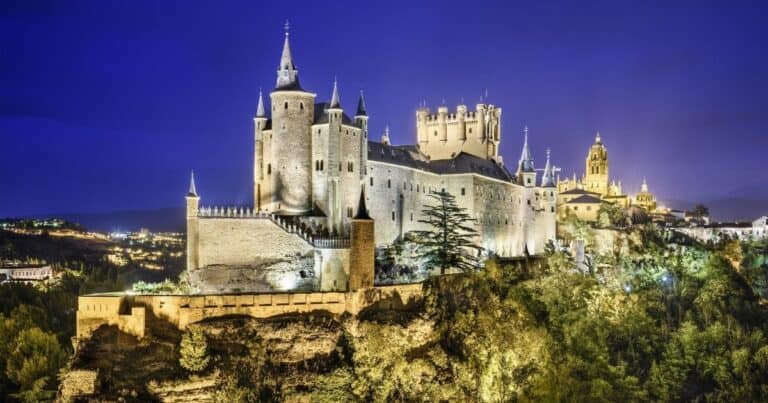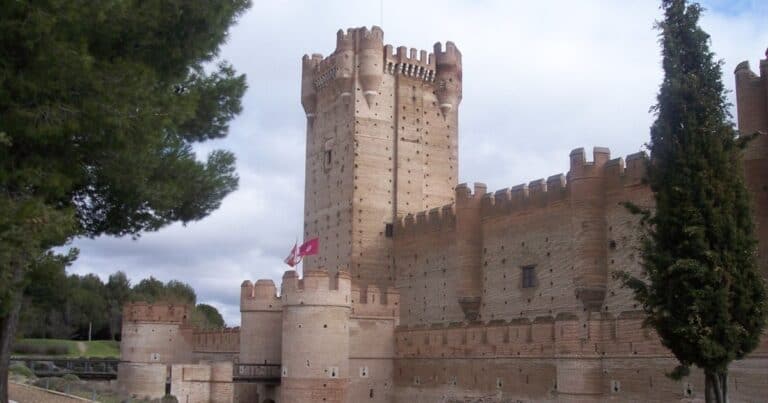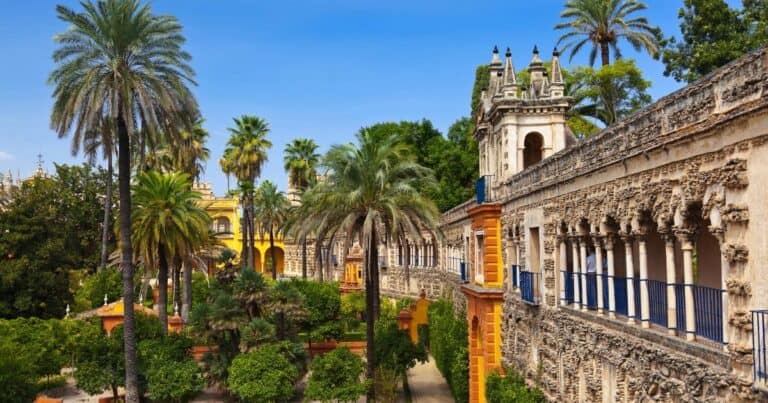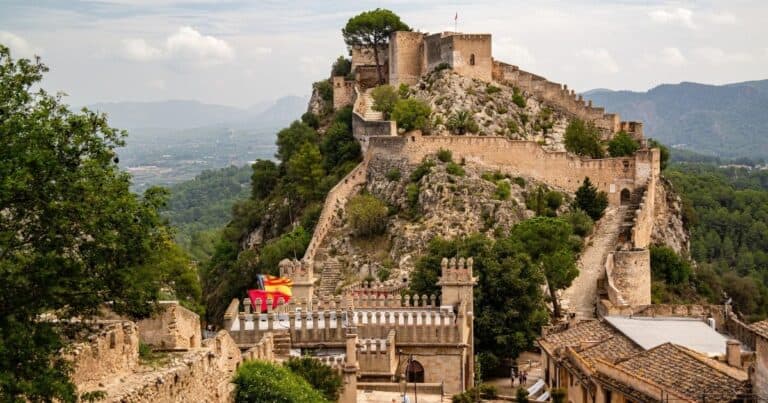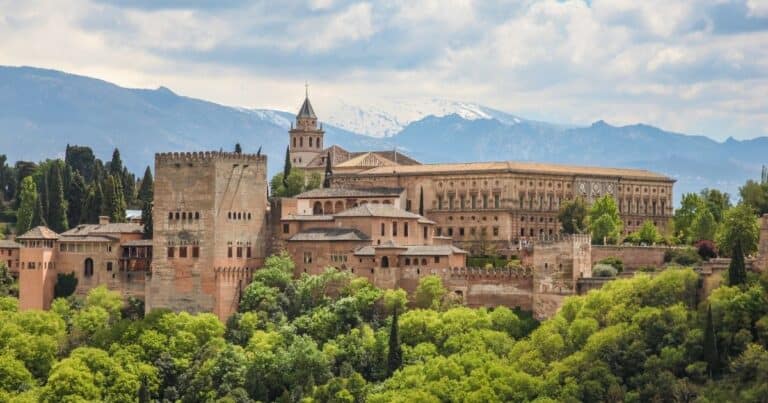Castillo de Colomares: A Tribute to Spain’s Age of Discovery
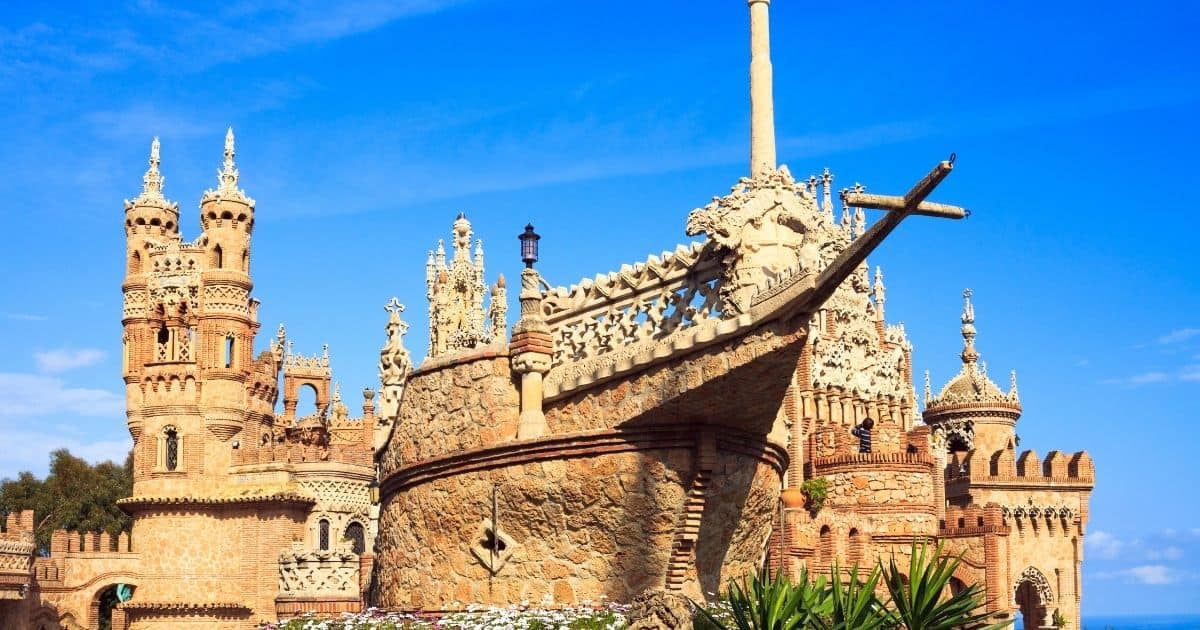
Welcome to Castillo de Colomares, a remarkable monument that stands as a tribute to Spain’s rich history and the era of exploration and discovery. Located in Benalmádena, Andalusia, this architectural masterpiece is often hailed as a fairy-tale castle, captivating visitors with its unique design and captivating ambiance.
Constructed between 1987 and 1994 by the visionary Dr. Esteban Martín Martín, the Castillo de Colomares is a must-visit tourist attraction in Spain. Its grandeur and historical significance make it a must-see landmark in Andalusia.
Key Takeaways:
- Castillo de Colomares in Benalmádena, Andalusia, is an architectural masterpiece dedicated to Christopher Columbus.
- The castle showcases a blend of Gothic, Mudéjar, and Byzantine architectural styles, creating a captivating structure.
- Dr. Esteban Martín Martín, the visionary behind the castle, wanted to create a lasting tribute to Spain’s Age of Discovery.
- Benalmádena’s connection to Columbus and its rich maritime tradition make it the perfect location for this historical landmark.
- Inside the castle, visitors can explore grand hallways, Gothic chambers, Mudéjar rooms, and dedicated spaces honoring Christopher Columbus.
Historical Background: Dr. Esteban Martín Martín’s Vision
Dr. Esteban Martín Martín, a physician and history enthusiast, had a profound vision to create a lasting tribute to Christopher Columbus and the Age of Discovery. Inspired by his passion for history, Martín embarked on the construction of Castillo de Colomares, investing his own resources and energy into bringing his dream to life. Despite lacking a background in architecture, he meticulously planned and executed the project, pouring his love for history and Columbus into every aspect of the castle’s design. The result is a magnificent monument that stands as a testament to Martín’s dedication and Spain’s enduring legacy.
The Symbolism of Benalmádena: A Connection to Columbus
Benalmádena, the picturesque town where Castillo de Colomares is located, holds profound symbolism in its connection to Christopher Columbus. Though Columbus himself never set foot in Benalmádena, the town’s strategic location overlooking the Mediterranean Sea represents the boundless horizons and uncharted waters that called to explorers like Columbus. Benalmádena’s rich maritime tradition, with ships setting sail on adventurous voyages, mirrors Spain’s pioneering spirit in naval exploration. Choosing this town as the site for the monument to the Age of Discovery captures the essence of exploration, the allure of the unknown, and Spain’s indomitable spirit of adventure.
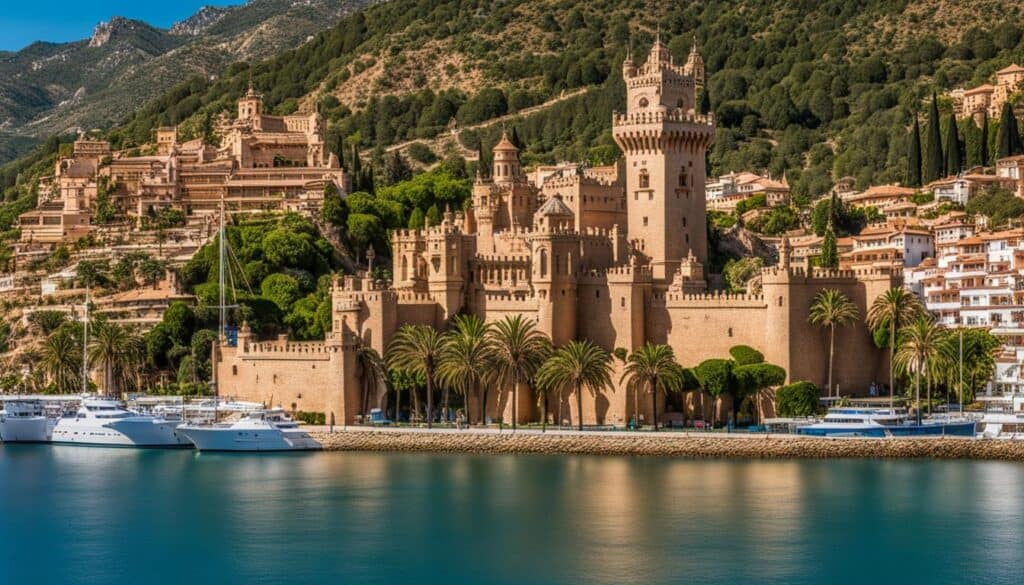
| Symbolism of Benalmádena | Connection to Columbus |
|---|---|
| Strategic location overlooking the Mediterranean Sea | Representing the boundless horizons and uncharted waters that called to explorers like Columbus |
| Rich maritime tradition | Mirroring Spain’s pioneering spirit in naval exploration |
| Chosen as the site for the monument to the Age of Discovery | Capturing the essence of exploration, the allure of the unknown, and Spain’s indomitable spirit of adventure |
Architectural Influences: A Testament to Spain’s History
The architectural influences of Castillo de Colomares highlight the rich tapestry of Spain’s history and cultural evolution. The castle masterfully combines elements of Romanesque, Gothic, Mudéjar, and Renaissance styles, resulting in a captivating and visually stunning structure.
Romanesque: The Romanesque elements of Castillo de Colomares pay homage to the grandeur of medieval Europe. The semi-circular arches and sturdy pillars evoke a sense of strength and solidity, mirroring the architectural motifs prevalent during that era.
Gothic: The Gothic features of the castle symbolize the spiritual quest for the divine and showcase the elegance seen in Gothic cathedrals. Pointed arches and ribbed vaults create a sense of verticality and celestial aspirations, transporting visitors to a time of religious fervor.
Mudéjar: The Mudéjar influence in Castillo de Colomares represents the intersection of Christian and Islamic cultures in Spain. Intricate brickwork and ornate tile mosaics display the exquisite craftsmanship and artistic fusion that emerged during this period of cultural exchange.
Renaissance: The Renaissance elements within the castle’s design pay tribute to Spain’s golden age of enlightenment and artistic achievement. Symmetrical designs and graceful curves reflect the pursuit of harmony, proportion, and beauty that defined this era.
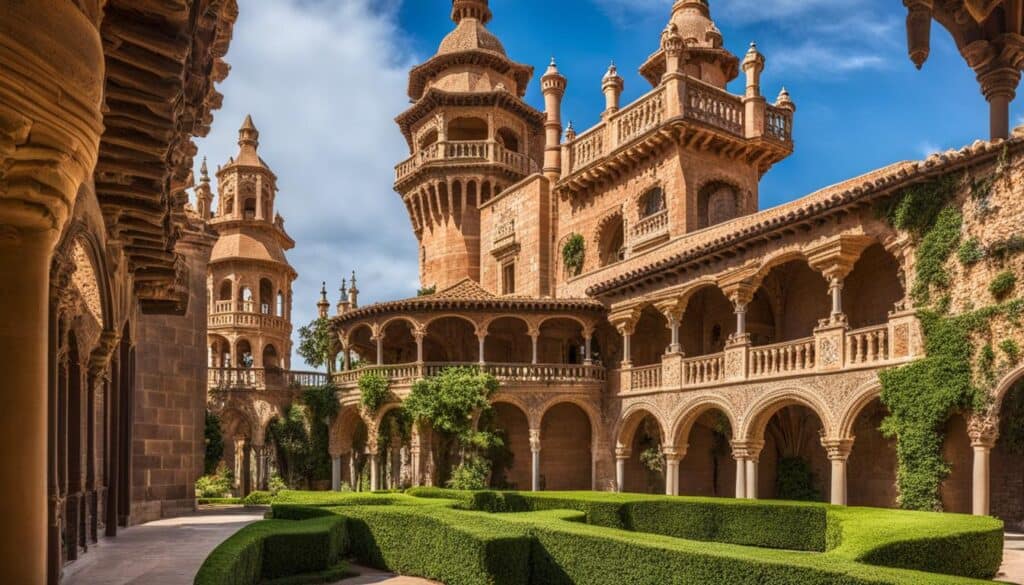
| Architectural Influences | Description |
|---|---|
| Romanesque | Evoke the grandeur of medieval Europe with semi-circular arches and sturdy pillars. |
| Gothic | Symbolize the spiritual quest for the divine with pointed arches and ribbed vaults. |
| Mudéjar | Represent the convergence of Christian and Islamic cultures in Spain with intricate brickwork and ornate tile mosaics. |
| Renaissance | Pay homage to Spain’s golden age of enlightenment and artistic achievement with symmetrical designs and graceful curves. |
Inside the Castillo de Colomares: A Journey Through History
Inside the Castillo de Colomares, visitors are transported through Spain’s rich history. The grand hallways, adorned with intricate carvings and mosaics, reflect the Romanesque influence and take visitors back to the medieval era. The Gothic chambers, with their pointed arches and tall windows, showcase the elegance and spiritual fervor of Gothic architecture. The Mudéjar rooms, with their intricate stucco work and tile mosaics, tell the story of the coexistence of Christian and Muslim cultures in Spain.
The castle also features dedicated spaces honoring Christopher Columbus, including a crypt and artifacts that chronicle his voyages. Observation towers provide panoramic views of the surrounding landscape, allowing visitors to immerse themselves in the atmosphere of exploration.
The Grand Hallways: A Glimpse into the Medieval Era
The grand hallways of Castillo de Colomares are a sight to behold. The intricate carvings and mosaics that adorn the walls transport visitors back in time to the medieval era. As you walk through these grand hallways, you can feel the weight of history and imagine the footsteps of knights and nobles who once graced these halls.
The Gothic Chambers: A Testament to Spiritual Fervor
The Gothic chambers within the castle exude a sense of elegance and spirituality. The soaring pointed arches and tall windows allow natural light to flood the rooms, creating an ethereal atmosphere. These chambers offer a glimpse into the gothic architecture that defined an era and the devotion it inspired.
The Mudéjar Rooms: A Fusion of Cultures
The Mudéjar rooms in Castillo de Colomares tell a story of cultural fusion and harmony. Intricate stucco work and beautiful tile mosaics reflect the influence of both Christian and Muslim cultures, highlighting the coexistence that characterized this period in Spain’s history. The Mudéjar rooms are a testament to the complexity and richness of Spain’s cultural heritage.
Honoring Christopher Columbus: A Crypt and Voyage Chronicles
Castillo de Colomares pays homage to Christopher Columbus, the legendary explorer who shaped history. Inside the castle, you’ll find a dedicated crypt where Columbus is honored and remembered. Additionally, artifacts are on display, chronicling his voyages and the impact they had on the world. These spaces offer a deeper understanding of the man behind the monument and his enduring legacy.
Observation Towers: A Panoramic View
The observation towers of Castillo de Colomares provide visitors with breathtaking panoramic views of the surrounding landscape. From these vantage points, you can gaze out over the picturesque surroundings, allowing yourself to be engulfed in the same awe-inspiring vistas that explorers like Columbus once beheld. It’s a chance to connect with the spirit of exploration and appreciate the beauty of Spain’s natural landscape.
Conclusion
Colomares Castle is a true architectural treasure that holds immeasurable historical significance. As a testament to the era of discovery and exploration, this stunning castle offers visitors a unique opportunity to journey through time and delve into Spain’s vibrant cultural heritage. With its seamless blend of Romanesque, Gothic, Mudéjar, and Renaissance architectural styles, Colomares Castle stands as a symbol of Spain’s architectural prowess and artistic brilliance.
Every nook and cranny of this magnificent castle tells a story, offering glimpses into the brave and curious souls who dared to venture into the unknown. From the grand hallways adorned with intricate carvings and mosaics to the Gothic chambers exuding spirituality, each section of Colomares Castle is a testament to the indomitable human spirit and the quest for knowledge.
For those seeking an unforgettable experience steeped in history and architectural marvels, Colomares Castle is an interesting and must-visit tourist destination.
FAQ
What is Castillo de Colomares?
Castillo de Colomares is a unique monument located in Benalmádena, Andalusia. It is a Spanish castle and a historical landmark dedicated to Christopher Columbus. It is also considered an architectural masterpiece and a popular tourist attraction in Spain.
When was Castillo de Colomares built?
Castillo de Colomares was built between 1987 and 1994.
Who is the architect of Castillo de Colomares?
Dr. Esteban Martín Martín, a physician and history enthusiast, is the architect and creator of Castillo de Colomares.
What is the architectural style of Castillo de Colomares?
The design of Castillo de Colomares combines elements of Gothic, Mudéjar, and Byzantine architecture.
What is the significance of Castillo de Colomares in relation to Christopher Columbus?
Castillo de Colomares serves as a tribute to Christopher Columbus and the era of exploration and discovery. It showcases Spain’s cultural tapestry during the Age of Discovery.
Where is Castillo de Colomares located?
Castillo de Colomares is located in Benalmádena, Andalusia, Spain.
What can visitors expect to see inside Castillo de Colomares?
Inside Castillo de Colomares, visitors can explore the grand hallways, Gothic chambers, and Mudéjar rooms. There are also dedicated spaces honoring Christopher Columbus, including a crypt and artifacts highlighting his voyages.
Are there observation towers in Castillo de Colomares?
Yes, Castillo de Colomares features observation towers that provide panoramic views of the surrounding landscape.
Why is Benalmádena significant in relation to Castillo de Colomares and Christopher Columbus?
Benalmádena holds symbolism as it represents the uncharted waters that called to explorers like Columbus. The town’s maritime tradition mirrors Spain’s spirit of exploration, making it an appropriate location for the monument to the Age of Discovery.

